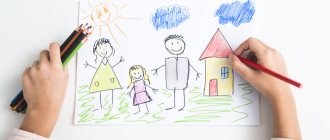Parent meeting “Psychological health of preschoolers” (in the middle group).
Protocol No. 2
Parents' meeting
dated December 12, 2019. Present: 12 parents.
Agenda.
- Speech by teacher Bazanova V.V. “Our successes and achievements, or what we do in kindergarten!”
- Speech by educational psychologist Kosenko L.V. on the topic: “Psychological health of preschoolers.”
- Questionnaire “Emotional and personal development”.
4. Training exercise “Flower”.
5. Miscellaneous.
Speech by a psychologist at a parent meeting
"Psychological health of preschool children."
We live in an era of socio-economic instability in society, which leads to an increase in the number of preschool children with disorders in behavior and emotional and personal development; Many children have increased levels of anxiety and low self-esteem. It is within our power to help them overcome these difficulties and create a desire to communicate. And it is advisable to do this while the child is still small: it is known that problems usually only get worse with age. Therefore, along with the development of the child’s mental functions and intelligence, we must in no case forget about the development of his emotional sphere.
The main condition for the neuropsychic development of a child is a calm and friendly environment in the family. It is important to provide the child with more independence and give him the opportunity to communicate with other children and adults outside the home. Children who suffer from insufficient communication with adults, as well as children who grow up in conditions of family discord, divorce, may develop mental disorders, manifested in the emergence of self-doubt, causeless anxiety, fears, sleep disturbances, headaches, and related disorders. with food intake, and other phenomena of nervousness. They may be temporary, but if the situation in the family does not change, the resulting disturbances begin to appear frequently, persistently and lead to social maladaptation and neuroses. Usually children do not realize the reasons for their own experiences and grief. Unfortunately, sometimes many adults do not understand them. It is very important to ensure the emotional well-being of the child to the family, because every child needs love, affection, understanding, and a kind attitude towards himself.
Preschool children are characterized by some features of emotional development:
— mastering social norms for expressing feelings;
- changing the role of emotions in his activities, the formation of emotional anticipation;
- development of feelings, they become more conscious, generalized, reasonable, arbitrary, non-situational;
- formation of higher feelings - intellectual, ethical, moral.
Emotions play an important role in children’s lives: they help them perceive reality and respond to it. Manifesting themselves in behavior, they inform the adult about what the child likes, what he is angry about, or what he is upset about. As a little person grows, his emotional world becomes richer and more diverse. From basic ones (fear, joy, sadness, etc.) he moves on to a more complex range of feelings: delighted, surprised, angry, jealous, sad.
The external manifestation of emotions, the form of expression of the subtlest shades of experiences also change: with the help of glances, smiles, gestures, intonations, movements, etc.
Basic needs typical for a preschool child:
- in positive emotions, love, recognition;
- communication (with adults and peers), cooperation, mutual understanding and empathy of an adult, his respect, in socially significant activities;
- new impressions, knowledge; the ability to feel competent;
- assessment of the results of their activities by adults;
- compliance with a positive moral standard.
It is known that a child’s self-esteem is formed under the influence of evaluation from significant adults from the immediate environment. The reasons for the formation of low or high self-esteem and the occurrence of anxiety in preschool age are different, but we would name the main one - a violation of parent-child relationships.
Anxiety.
This individual psychological feature is manifested in a person’s tendency to frequent and intense experiences, a state of anxiety, an increased tendency to experience anxiety in a wide variety of life situations, including those that do not encourage this.
Anxiety is a stable condition, considered as a personal formation or a property of temperament, caused by the weakness of nervous processes.
So, if a child hardly smiles, is depressed, lacks initiative, if he does not play with peers, he is in a bad mood or has constant anxiety, irritability, and difficulty concentrating on anything. If muscle tension, sleep disturbances, etc. are detected. the child's emotional background is negative.
If for some reason a preschool child feels unwell, he may develop psychomotor agitation, tics, stuttering, or a depressed, inhibited state.
Internal conflict in a child caused by the following reasons:
- authoritarian parenting style on the part of significant adults;
- contradictory and excessive demands made by parents and educators;
- inconsistent demands from parents and educators;
- inflexible approach of adults to the situation related to the child;
— inadequate requirements; children experiencing failure develop high anxiety;
- negative demands that humiliate the child and put him in a dependent position.
The child’s internal conflict is also very often correlated with complications in relationships with parents, educators and peers. Emotional distress associated with difficulties communicating with other children can lead to two types of behavior:
- negative vivid emotional reactions (anxiety manifests itself through aggressiveness);
-stable negative attitude towards communication (restrained reaction, isolation, avoidance of communication).
An important factor is the individual characteristics of the child, the specifics of his inner world: impressionability, receptivity; tendency to worry, uncertainty, timidity; often anxiety increases under the influence of overwork.
The principle of upbringing and development should be built in relation to the child as the one and only. It should be borne in mind that every second of time that passes has an impact on the child. He needs to be given a chance, the opportunity to realize himself, to feel that everything is fine with him and that they believe in him. This is how the child’s psychological health and the successful development of his personality are “developed.”
The formation of mental processes and the personality of a child as a whole is a complex process that requires joint efforts of both teachers and parents.
3
Parent meeting in the middle group on the topic “Age characteristics of 4-5 years”
Provide the child with the opportunity to play together with other children
, realizing that such a game not only develops his imagination and imaginative thinking, but is also absolutely necessary for healthy emotional development. Offer the child for play not only toys that are complete in form, but also unshaped objects that do not have a clear function: pebbles, sticks, blocks, etc.
Understand that the child is already capable of doing what he likes for a long time and enthusiastically, and it can be very difficult for him to interrupt the game
, so it’s worth warning him in advance about the need to finish it.
Be open to your child's questions
, be interested in his opinion, turning his thirst for knowledge into the ability to find answers to questions that interest him. It is useful to discuss with your child any events and phenomena that interest him, and in his language to formulate the results of your joint reasoning and conclusions.
Blitz survey of parents on actively manifested characteristics in children of our group
What should a 4-5 year old child know and be able to do?
Speech development:
Correctly pronounce all the sounds of your native language;
Use nouns in speech that denote professions;
Use nouns with a general meaning: vegetables, fruits, berries, animals;
Agree words in gender, number, case;
Use sentences with homogeneous members;
Retell short literary texts, compose a story based on a plot picture, toy, objects;
Be able to answer questions based on the content of what you read;
Read short poems and nursery rhymes by heart;
Reproduce the content of works of art using the teacher’s questions.
Cognitive development:
Count within 5 (quantitative counting), answer the question “how much in total”;
Compare 2 groups of objects using counting;
Compare 5 objects of different lengths and heights, arranging them in ascending order by length and height;
Recognize and name a triangle, distinguish it from a circle and a square;
Distinguish and name parts of the day;
Determine the direction of movement from yourself (right, left, forward, backward, up, down);
Know your right and left hand;
Know and name the main parts of a building material (cube, block, plates);
Learn to analyze a building sample: identify the main parts and distinguish them by size and shape;
Be able to design from paper: bend a rectangular sheet of paper in half, matching the sides and corners;
Be able to identify the characteristics of objects (color, shape, size);
Determine the material from which the thing is made (wood, metal, paper, fabric);
Know furniture, clothing, dishes, some fruits, transport (cars, trains, planes, ships) in the immediate environment;

